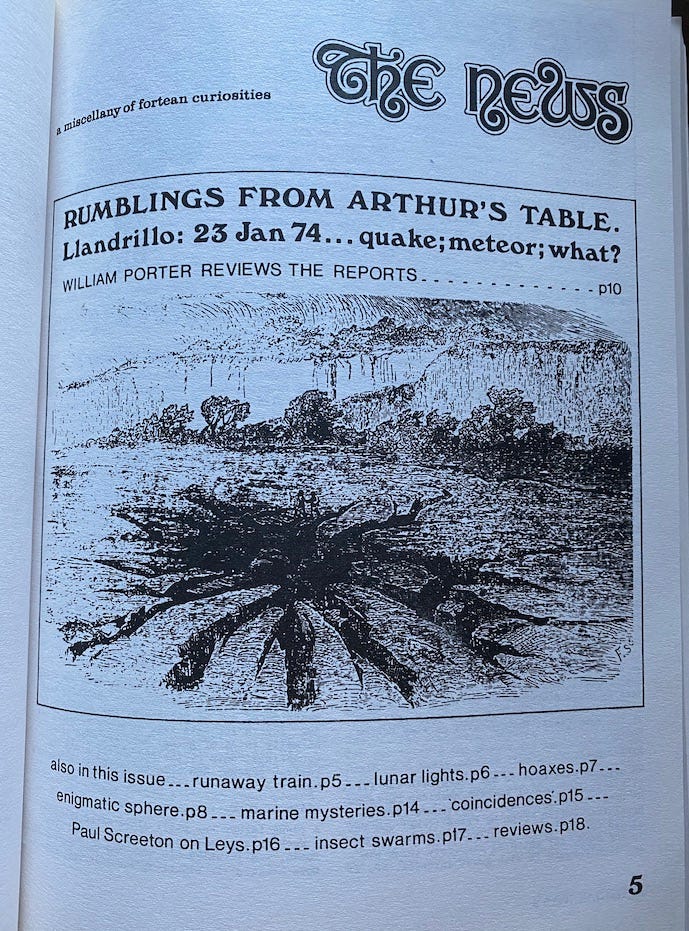I’m reading through my bound editions of early Fortean Times magazine, starting with issue #1. It’s the only way to see these issues which are long out of print (as are these bound volumes). It was very tough to get this collection. But my intent was to see what stories surfaced long ago (starting in November 1973) and how they were presented.
The text is tough to read with old typed print and the pages bound so close to the edge. But, pushing through the eye strain, I found some interesting things as I expected. I wrote this up as a thread on my Mastodon account but am putting it together here with a bit of added commentary. It is very piecemeal and based on my personal interests of the topics covered. So what follows are gems I spotted in the content that may be appreciated by students of natural anomalous phenomena. That’s my jam.
At this stage, the magazine was created from news clippings of strange observations around the world and contributions by other writers and investigators. It was called The News: a miscellany of fortean curiosities
The Berwyn Mountain UFO
The Berwyn Mountain UFO incident is a fascinating and still mysterious tale that took place in North Wales in January 1974. Also known as Roswelsh and Llandrillo, the news first appeared in Fortean Times issue 3 (March 1974) and continued in issues 4 and 5. The incident included a green fireball, an explosion, and seismic activity. It has its own Wikipedia page. It is interesting to read these contemporary accounts. People saw the light, felt shaking and heard sounds. The location is along a known fault line. So, this is prime material for Spooky Geology. I have gathered a number of sources to dig into in the past several years but it’s awesome to find these contemporary accounts. In the reports, the Fortean Times writer references The Ley Hunter ‘zine of March 1974. Thanks to the incredible work of Issac Koi, you can also read this online at the repository at the Archives for the Unexplained. The official explanation was that seismic activity coincided with a meteor. There is a lot to unpack in those words which conjure up ideas of earthquake lights. Were they earthquake lights? It’s not clear. For a rundown of the current state of earthquake lights, see my Spooky Geology piece: Earthquake Lights
Ley lines
Leys or leylines were a hot topic in the 1970s when they were heavily steeped in supernatural connotations related to hauntings and UFOs. Alfred Watkins in the UK developed the concept starting in his first book in 1922 simply as ancient alignments of important prehistoric structures. But Paul Screeton in FT 5 insists that Watkins was a closet psychic who really knew these were more than just alignments but "paths of subtle current" whose power and utility would soon be revealed to all (1974). Well, that sure didn’t pan out. Later in issue 7, famous Fortean supernaturalist Janet Bord insists that people are locating leylines incorrectly. She rightfully asks just how wide are leys on the ground versus how they are drawn on a map? How close do the features need to be to draw energy from the ley? Can it be just touching the line or must the line run through the center? These are age-old questions that never really needed an answer, it turned out.
Ice falls
There are almost countless incidents of large chunks of ice falling out of a clear sky. Reports appear in issues 3 and 6. Unfortunately, the photos don't reproduce well so I can’t see details. But there is NO doubt ice falls happen maybe a few times a year around the world. Because it occurs often near airports, the best guess is ice that has accumulated on the plane dislodges during the descent. There are also cases of megacryometeors - giant aggregated hailstones, however, that term wasn’t invented until 2000. Large chunks of falling ice damage homes with alarming frequency. Sometimes people are injured. Little follow-up is usually given to these cases, like the one near Philadelphia a few weeks ago which made the Weekly Weird Newsletter. Ice falls deserve more attention, for sure.
Source of Sourcebooks
Every Fortean worth a damned knows of William Corliss. Corliss, who lived in Maryland, self-published "Sourcebooks" of anomalies, following the path of Charles Fort himself. Corliss writes in Fortean Times 7 that he was inspired by George McCready Price's book on Catastrophism as an "outlaw science" to do the Sourcebooks. This information bummed me out. Price was an anti-evolution Creationist. You can taste the negativity delivered by Corliss whenever he mentions evolution in the sourcebooks. I really dislike that underlying tone in Fortean stuff. Not only is it unnecessary to reject evolution to study anomalies, but it also undermines credibility if you have even a whiff of a religious agenda. Yet, Corliss doesn’t embrace Creationism, as he explains in this important essay, he wishes to present the data with references. An admirable process that I am very grateful for. This was a gem of a find.
Bermuda Triangle
Charles Berlitz' book The Bermuda Triangle (1974) was serialized in the UK Sunday Express in 1975 making his inaccurate descriptions of missing boats and planes and fringe ideas about Atlantis, etc. widely available. The book reviewer in issue 9 says people should make up their own minds about the data, but it clearly showed that weird things happen more in that area. Except weird things didn’t happen more in that area. Larry Kusche's book demolishing Berlitz came shortly after revealing that Berlitz' nonfiction was atrocious and mostly wrong. Unfortunately, Berlitz’ ideas hung around through the 70s and the story of the Triangle, totally debunked, still resonates today. See “I Survived the Bermuda Triangle”.
Not-Deer
Finally, for this recap at least, my current knowledge of pop cryptids provided me a way to frame a contribution by Jerry Clark in issue 8. A cryptid made famous in the past few years thanks to dramatic stories and exaggerated videos on TikTok is the Appalachian critter called a "not-deer" which sort of looks like a deer until you REALLY look and find that it's not a deer. It displays unsettling characteristics that scare the heck out of people today (and may be attributable to wildlife diseases). Clark describes two "not deer" encounters he collected when he was Editor for Fate magazine around 1971. The animals were not afraid of humans or guns and upon reflecting, the witnesses said they were not like any other deer they’d ever seen. My interest perked right up at these tales that precede the “not deer” concept by decades. Perhaps the idea was old yet the name itself and its popularity on social media made it the star Pop Cryptid that it is today. Very interesting.
If you enjoyed this foray into 1970s Forteana, please share with someone else who might. Maybe I’ll do another installment as I work my way through the old volumes for modern connections.






Thanks for the William Corliss ref - never heard of him and he seemed pretty prolific!
Enjoyed that article.